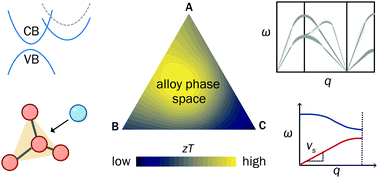Computational design of thermoelectric alloys through optimization of transport and dopability†
Abstract
Alloying is a common technique to optimize the functional properties of materials for thermoelectrics, photovoltaics, energy storage etc. Designing thermoelectric (TE) alloys is especially challenging because it is a multi-property optimization problem, where the properties that contribute to high TE performance are interdependent. In this work, we develop a computational framework that combines first-principles calculations with alloy and point defect modeling to identify alloy compositions that optimize the electronic, thermal, and defect properties. We apply this framework to design n-type Ba2(1−x)Sr2xCdP2 Zintl thermoelectric alloys. Our predictions of the crystallographic properties such as lattice parameters and site disorder are validated with experiments. To optimize the conduction band electronic structure, we perform band unfolding to sketch the effective band structures of alloys and find a range of compositions that facilitate band convergence and minimize alloy scattering of electrons. We assess the n-type dopability of the alloys by extending the standard approach for computing point defect energetics in ordered structures. Through the application of this framework, we identify an optimal alloy composition range with the desired electronic and thermal transport properties, and n-type dopability. Such a computational framework can also be used to design alloys for other functional applications beyond TE.



 Please wait while we load your content...
Please wait while we load your content...